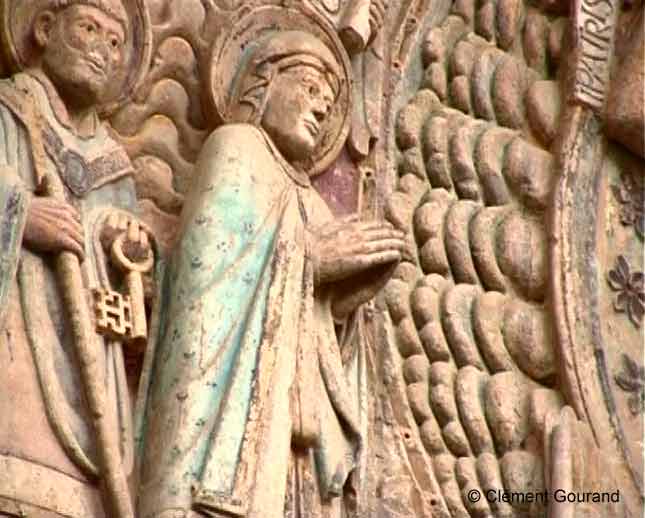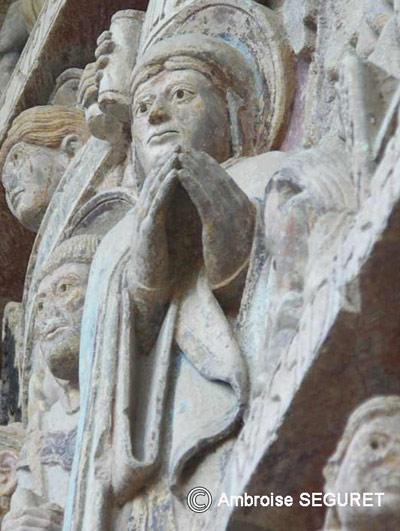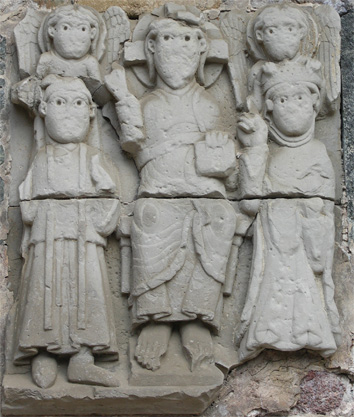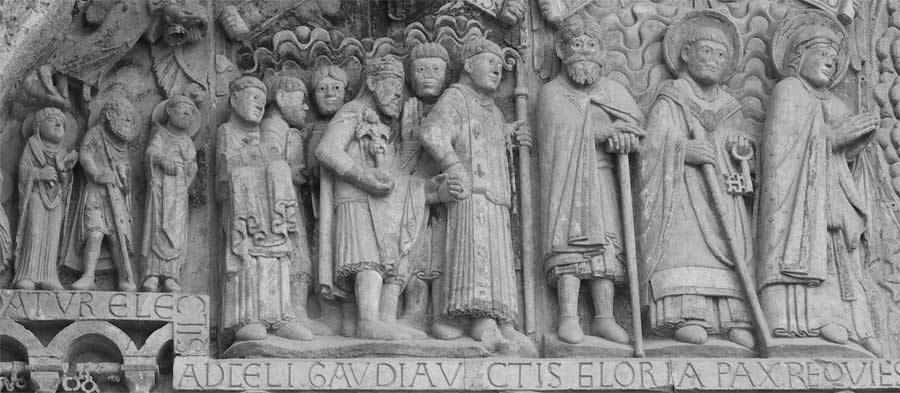| Monks’ Calendar | Suffrages | Saint Faith | Slideshow |
The Upper floor: the New Testament era
A
monastic calendar
We are now in the presence of a timeline that runs from zero of the Christian
era to the present time, namely the early twelfth century.
It is the time of "the marching Church": 13 standing
or walking characters, their body almost in profile, are advancing towards
Christ. They are guided by three larger characters, represented nearly
from the front: at the head of the chosen ones, Mary, the mother of Jesus,
followed by St. Peter (1), founder of the Church who holds the
key to Paradise, and finally Dadon, the hermit who led to the founding
of the shrine in Conques (Cf. chronicle of the abbey).
All three are largely bathed in the divine waves. Then comes the procession
of ten characters of progressively decreasing size as one moves away in
time according to the laws of perspective, thus giving a tangible perception
of time. Represented mostly in three-quarter, these characters move toward
Christ under the leadership of the abbot of Conques who is recognizable
thanks to his pastoral cross. Central pivot of the calendar, he embodies
the present and its optimistic climate. (More about the euphoric context
of the First Crusade)
The last one, on our left, a very small, almost crouching, is Mary
Magdalene ; she is represented "turning
backwards". With Mary, the "strong woman", these are
two female witnesses of the risen Christ framing the procession.
By simply dating each character in the frieze, one will see a calendar
that indicates the milestones of the way to salvation during the Christian
era:
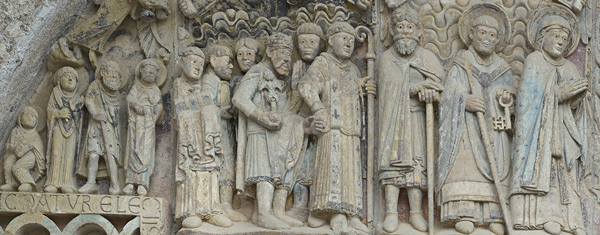
Procession of the New-Testament chosen ones (pass the mouse over
the image to see the legend) |
||||||||||
| Mary-Magdalene | the Abbot |
Dadon |
Saint Peter |
Mary |
||||||
date |
0 |
303 |
356 |
400 |
800 |
1130-40 |
750 |
64 |
0 |
|
the present |
The first four periods of the early Church are represented by four small haloed characters constituting an allegorical typology that breaks the early Christian centuries into four moments:
- The disciples (Mary Magdalene, "Apostle to the Apostles". To learn
more about the twist backwards, worship, relics, tapestries and the image
of women, see Mary Magdalene);
- The martyrs (Saint Faith represented with her palm.
To learn more about her relics, her priesthood, her liturgy in Conques,
see Foy);
- The anchorites (St. Anthony
the Great. To learn more about this hermit of the Egyptian desert, see st. Anthony’s page);
- And finally that of the Fathers of the Church (St. Hieronimus referred to by his phylactery).
Then comes the time of Charlemagne. The Carolingian dynasty is represented
by the Emperor, his son Louis the Pious, King of Aquitaine and then Emperor
and by William Gellone dubbed short nose, Charles Martel’s grandson,
therefore Charlemagne’s first cousin. This triad of royalty and
war heroes may seem surprising in the cohort of the chosen ones. Beyond
their submission to the Church, their mythical presence corresponds to
a deliberate intention related to the context of the political and literary
construction of the tympanum which we expose in the section of the Carolingian
myth. (Subheadings Charlemagne, William of Gellone, Louis
the Pious, mythology...)
Next
come two clerks who symbolize the presence of the Church, especially through
the monastic orders, such as that of st. Benedict which our abbey belongs
to. The first monk presents on a piece of cloth Gospels that are recognizable by their binding. The second holds the Tablets
of the Law thus demonstrating the continuity between the
Old and New Testaments, critical milestones of the path to salvation.
(Read more about the representation of the Torah and the Gospel)
One notices on the lower floor a space-time structure that is strictly
opposite to that of the Old Testament.
In the Limbo, the central character, Abraham, father of the Chosen ones,
indicates the earliest times, and on both sides, the characters are ordered
from the oldest to the newest one as they recede from the first patriarch.
At both ends, Mary Magdalene on one side, Ezekiel on the other, hold key
positions that ensure transition.
However, in the procession of the
new times, the central axis, placed below Abraham, is occupied by the
abbot of Conques who embodies the present time.
The other characters are arranged chronologically but in an inverse symmetry,
from the newest to the oldest to the right as well as to the left, and
one finds, at each end, on one side Mary Magdalene; on the other the Virgin
Mary. (2)
(Top)
SUFFRAGES* AND PURGATORY*
Mary "Mother of the Church", "Advocata nostra",
is represented with clasped hands, fingers lightly touching the waves
of the of her son’s mandorla. In a position of prayer, she obviously
intercedes with her son.
And for whom, unless it is for those in the Tartarus*?
This intercession shows that is not a definitive hell with sinners damned
to eternity. If this were the case, what could be the point of this prayer?
The development of Marian devotion has of course its corollary the birth
of purgatory* and the theory of the suffrages*
of the Saints.
The chosen ones who are in the angelic (or heavenly) Mansions* under the protection
of the roof formed by the virtuous phylacteries held by the angels are
far from being perfect. More than half of them does not have a halo (3)
! Paradise, therefore, is not confined to saints, martyrs or blessed ones...
One finds among them a renegade (St. Peter), a "sinner"
(4) (more information about Mary
Magdalene), a matricide (the hermit Dadon) (5), and
even an intemperate incestuous (Charlemagne)! All are far from being saints,
and yet they are all saved, because they have believed.
These notorious sinners have either received the grace upon their particular
judgment* or they have already been restored*,
justified* by purgatorial fire.
One should notice the distance
between the text (theory) and the illustrations (reality): in fact, finding
among the chaste (CASTI) and peaceful (Pacifici) a character like Charlemagne
can let one thoughtful ... However, the Benedictines of the twelfth century
did not doubt that, because of his piety, the Frankish king deserved his
place in the angelic Mansions*.
If the inscriptions recall the Law and its severity, the images in the
stone and in the retina of the pilgrim illustrate a different reality,
where grace accomplishes mercy: that grace itself is visible, materialized
by the waves that bathe the celestial procession of the chosen ones.
(Top)
Saint Faith touched by the hand of God (Pass your mouse over the picture to identify the objects)
This corner space is devoted to the girl martyr whose worship, pilgrimage and devotion paid to relics play an essential role in the reputation of Conques several centuries before the erection of the tympanum.
We summarized in the previous chapter
the four interpretations of this semiotically dense corner piece.
All the great themes of the tympanum are condensed here in allegorical
form: Continuity of Scripture, faith, salvation, priesthood, Church.
-
By its position between the records of the Old and New Testament,
it ensures the continuity of time between the old and the New Testament. - The allusion to priesthood is particularly stressed by many signs: the altar and the chalice (which recalls continuity of the sacrifice from Melchizedek to the contemporary priest celebrating the Eucharist), are the most obvious. But several symbols also refer to the heavenly priesthood that the Saint herself has received: the empty throne and the altar steps on which she kneels. (read more about the priesthood of Saint Faith) - The three arches, do not only materialize the basilica at Conques, but they also represent the entire Church and more, they summarize Christianity as a whole. (see the decoding of the symbolism of three arches) |
|
- Saint Faith’s Prostration, as she reclines before the hand of God, reflects the concentration of each being before the Judgment. This is an implicit manifestation of the self-awareness that emerges in the twelfth century.
SAINT
FAITH’s crowning
Another scene pays homage to Saint Faith. This is the one of her coronation,
because like the Virgin Mary, Saint Faith received her crown in Heaven.
This coronation is another manifestation of her priestly investiture,
as a martyr who shed her blood, after the example of Christ. This enthronement
is posthumous, in Heaven, and that is why the crown is round.
There were two representations of Saint Faith’s crowning at Conques:
one on the tympanum (below left) and another one (right) on the bas-relief
that adorns the tomb of Begon, abbot of the late eleventh century. (6)
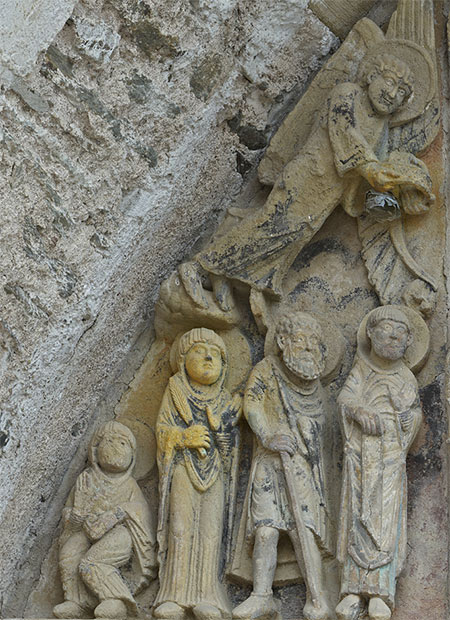
Heavenly coronation of Saint Faith: the angel takes the crown to heaven (detail of the tympanum) Click here to view zoom |
|
A POPULAR CULT
The cult of Saint Faith occupies a fundamental role in the abbey church
of Conques which is dedicated to it, to St. Saviour and to St. Peter.
Sainte Faith represents precisely the merciful concept of salvation as
evidenced by the anecdote related in the Book of Miracles of Saint Faith
written by Bernard of Angers around 1010: this learned schoolmaster was
outraged by the popular lay custom that mingled with the devout Office
of hours, "rustic songs, [...] wild and shrill screams, [...]
inept and futile laments, and other [...] absurd and intolerable frivolities."
To stop such practices deemed vulgar and inappropriate, the monks would
even close the doors of the abbey to these incongruous people. It was
then that the mischievous girl interfered in favor of the noisy faithful
that had been banished: she opened the doors miraculously! Touched by
the fervor of the humble ones, she responded to their supplications.
Reflecting as usual on the event, Bernard d'Angers turned the intervention
of the saint into a lesson in theology on the merciful nature of salvation
"God tolerated these practices and approved of them because of
the religious intention that inspired them and because of his condescension.
God is a compassionate father, full of pity for the weakness of his children,
he knows the frailty of their nature, and so instead of searching for
what can condemn man, he tries to discover the root of salvation in the
heart of the sinner." (Book One of the miracles of Saint Foy,
Chapter XII).
This story emphasizes the fact that the relationship
between faith and salvation is essential in the Romanesque monastic theology
and it helps to better understand the presence of notorious sinners in
the *angelic Mansions. (7)
The procession advances on the royal road of Christ: it manifests itself strongly in the priestly function, paced by the play of the pastoral rods (8) of St. Peter, of the Hermit Dadon (a "T" shaped rod), and of Abbot St. Anthony.
St. Peter deserves special mention. The apostle Simon, founder of the Church is the spiritual leader of the faithful. It is to him that the abbey church of Conques was originally dedicated. Through his writings, especially his two epistles, he seems to have directly inspired the designer of the tympanum. We notice more than a dozen matches between the stone book and Peter’s text . (more info)
Everything in the City of God, converges
to the theme of salvation*. Everything makes sense: characters, signs,
order and geometric construction. For example, the broken lines of the
roof on the arches, or of the angels' phylacteries protect; the arches
connect and support; the horizontal, vertical and oblique directions indicate
the sense of history or the correspondences; corners provide transitions...
Nothing is left to chance, not even the proportions
given to the characters or the area devoted to the City of God, clearly
superior to that of Tartarus, So that one wonders, as does Jacques Le
Goff when he concludes his book on Purgatory "if the driving
system of salvation has not been Paradise"? (9)
Let’s now cross to the Tartarus side.
Next chapter 5: The Tartarus
(1) St. Peter plays a fundamental role in the tympanum theological inspiration that seems to quote his two epistles literally. (Read more) (back to text)
(2)
We notice incidentally that the column of the pilgrim Church is framed
at both ends by women: Mary Magdalene opens on one side the procession
that the Virgin Mary leads on the other. This monastic calendar echoes
another calendar that we could call eschatological. In these times of
disruption, it marks the messianic history, explaining the step by step
progression, from the time of law to that of Faith to reach the "End
of Times". This calendar distinguishes seven successive periods of
a thousand years from Adam to Noah, from Noah to Abraham, from Abraham
to Moses, from Moses to Jesus, from Jesus to Zeno, from Zeno to Charlemagne,
and from Charlemagne to the present time that announces the Apocalypse
and the Second Coming. These seven eras correspond to the seven days of
Creation.
As the Hebrew calendar indicates that the world will last 6000 years spread
over seven days starting from 0 for Adam, "doomsday" according
to kabbalistic gematria is scheduled for the year 2240 of the Christian
calendar. Using the same method of numerology, the number 2240 gives a
figure 8 (2+2+4+0) which would correspond to the eighth day, the one that
will not end, the one of eternal life. (a posteriori, coincidentally,
the last word of the entries final admonition, FUTURUM, ends with an uncial
letter, "M" that looks like a lying 8, which evokes the yet
newer sign of infinity... see illustration).
Enough to fuel the more or less esoteric speculation of the "millenarians"!
(back to text)
(3) Among the seven characters placed between St. Peter and St. Jerome (ie Dadon, William, Charlemagne, Louis the Pious, and the 2 monks), none carries the halo of sanctity. (back to text)
(4) See the section devoted to Mary Magdalene, her turnaround and her mystical message. Mary Magdalene’s "turnabout" symbolizes the movement of the pagan world’s gaze towards the Messiah. Beyond the change of morals, it is the change of the laws of nature: the vision of the physical body transformed into a glorious body. (back to text)
(5) Dadon, lord of Conques, dispossessed of his castle by the Saracens, refuses to share his war horse against the release of his mother taken as hostage. Remorseful after the departure of the Saracens, he turned hermit and rebuilt the destroyed shrines. This happened a century before the transfer of Saint Faith relics to Conques. (See the chronicle of the abbey). (back to text)
(6) Bégon’s niche is embedded in the southern exterior wall of the abbey, on the side of the cloister. (back to text)
(7) The Scriptures associate salvation to faith: "Go, your faith has saved you" (Mk 10 52 or Lk 7 50) and "You'll get the salvation of your souls for your faith." (Peter 1 1.9) (back to text)
(8) Perdendicular to the ground, the abbot’s and Dadon’s rod follow the vertical direction of the Cross, the axis of the transcendental manifestation of the divine. But two of them are oblique, following the famous "diagonal of grace": that of St. Anthony who resisted his famous temptations and that of St. Peter, which points directly to the lock on the door of Paradise whose key he holds . (back to text)
(9)
"About to finish this book, an anxiety seized me. My intention
was to suggest that in this system [ the Hereafter] the main place was
the intermediate, ephemeral, fragile yet essential, Purgatory, which became
a place between Heaven and Hell.
But is this the truth of the system?
We could ask ourselves whether the driving force has not been the organization
of the Paradise, which has been of so little interest to historians and
which, if I check my files, does not seem so bland and monotonous as is
said." (Jacques Le Goff, The Birth of Purgatory, Folio
History, 1981, p. 484). (back to
text)
| Top |
